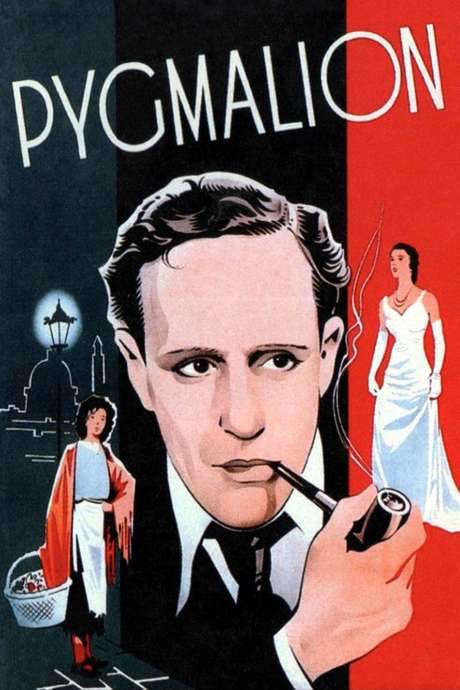
Pygmalion
Year: 1938
Runtime: 96 mins
Language: English
Director: Anthony Asquith
Professor Henry Higgins boasts he can turn Cockney flower girl Eliza Doolittle into a lady in six months, prompting Colonel Pickering to fund the wager through an agreement with her dustman father. Eliza moves into Higgins’s home for rigorous speech training, while other characters also undergo their own transformations.
Warning: spoilers below!
Haven’t seen Pygmalion yet? This summary contains major spoilers. Bookmark the page, watch the movie, and come back for the full breakdown. If you're ready, scroll on and relive the story!
Pygmalion (1938) – Full Plot Summary & Ending Explained
Read the complete plot breakdown of Pygmalion (1938), including all key story events, major twists, and the ending explained in detail. Discover what really happened—and what it all means.
One evening in Covent Garden, as passers-by murmur about language, linguist Henry Higgins [Leslie Howard] is mistaken for a policeman, triggering protests from Eliza Doolittle [Wendy Hiller], a sharp-tongued flower seller. The disruption catches Higgins’s attention, and he talks with Colonel Pickering [Scott Sunderland], a fellow language enthusiast who has come from India to study him. Higgins argues that, with his method, Eliza could speak with the elegance of high society and might even pass as a duchess. This audacious claim sparks a bold bet with Pickering: if Higgins can transform Eliza, he will cover all the expenses of her training and testing against a future of greater opportunity.
The next morning Eliza arrives at Higgins’ house to request elocution lessons. Mrs Pearce [Jean Cadell], the housekeeper, prepares Eliza for the day, giving her a bath while Alfred Doolittle [Wilfrid Lawson], Eliza’s father and a workingman with a sly sense of humor, arrives to demand compensation for the damage done to his daughter’s life. Higgins is amused by Doolittle’s roguish charm and offers him ten pounds, but Doolittle rejects the sum, insisting that, as one of the “undeserving poor,” he only wants enough for a one drunken weekend. The scene sets up a tension between aspiration and practicality that threads through the entire story.
After a rigorous internship, Eliza is invited to an at-home gathering hosted by Mrs Higgins [Marie Lohr], Higgins’ mother. There, though she speaks with a cultivated, upper-class accent, Eliza’s slang-filled chatter and profanity shock the guests. Yet among them is Freddy Eynsford-Hill [David Tree], a young man who becomes fascinated with her. When the guests depart, Mrs Higgins voices her concern that Eliza’s two benefactors treat her more as a project or a toy than as a person with a real life and feelings.
Weeks of coaching follow, culminating in a formal embassy reception. Higgins and Pickering fear Eliza may be exposed by a clever observer, Count Aristid Karpathy [Esme Percy], a Hungarian who has earned fame for tutoring American heiresses in elocution and for his knack of tracing social origins through speech. Eliza’s performance at the embassy is so seamless that Karpathy briefly entertains the notion that she could be a princess, a testament to her transformation under Higgins’s tutelage. The triumph, however, leaves Eliza unsettled and resentful: Higgins and Pickering seem to celebrate their method while overlooking her commitment and the depth of her own needs.
Back at home, the victory feels hollow for Eliza. Higgins tries to persuade her to return to him, but she pushes back, arguing that he merely takes her for granted. She hints at independence, even suggesting she could offer elocution lessons herself to earn a living, if necessary. The rift widens as she asserts her own desires—she would rather marry Freddy, who is charming though financially unstable—forcing Higgins to confront the price of progress and the limits of his mentorship.
That night, Higgins returns home after a long walk and unintentionally plays a recording of Eliza’s first visit. He is confronted with the memory of her raw, unpolished self, and when Eliza appears at his study door, she quotes her earlier self with a sly rebuke, asking for the slippers he has forgotten. The moment crystallizes the unsettled, evolving relationship between teacher and pupil. The story closes with their future together left deliberately open, balancing pride, affection, and the possibility of genuine partnership as Eliza asserts her own evolving identity.
I washed my face and hands before I come, I did
The characters are brought to life by a cast who each contribute a distinct thread to this exploration of language, class, and personal agency. Higgins’s rigorous, almost scientific approach contrasts with Eliza’s emerging self-determination, while Mrs Pearce’s steady presence and Mrs Higgins’s maternal concern offer grounding perspectives. The bystander figures and social settings—the Covent Garden bustle, the gracious drawing rooms, and the embassies—provide a textured backdrop that highlights the social dance at the heart of this story, where words become a key to opportunity, status, and identity.
Last Updated: October 09, 2025 at 10:47
Unlock the Full Story of Pygmalion
Don't stop at just watching — explore Pygmalion in full detail. From the complete plot summary and scene-by-scene timeline to character breakdowns, thematic analysis, and a deep dive into the ending — every page helps you truly understand what Pygmalion is all about. Plus, discover what's next after the movie.
Pygmalion Timeline
Track the full timeline of Pygmalion with every major event arranged chronologically. Perfect for decoding non-linear storytelling, flashbacks, or parallel narratives with a clear scene-by-scene breakdown.



